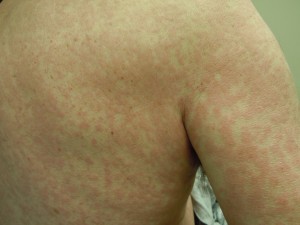 Any medication has the potential of causing allergic reactions. About 5-10% of the adverse drug reactions are due to allergy.
Any medication has the potential of causing allergic reactions. About 5-10% of the adverse drug reactions are due to allergy.
Drug allergies can assume many forms. A reaction can happen after a few doses of the offending medication, but may occur even after the first dose. Skin rashes are the most frequent presentations. The most common type is morbilliform rashes (red flat spots or raised bumps that blanch with pressure). Hives and swelling are often seen. Occasionally skin eruptions can appear on mucosal linings (inside the mouth, eyes, or genital areas). Blistering and skin detachment (Stevens-Johnson syndrome and toxic epidermal necrolysis) can cause serious complications. Severe immediate type of allergy called anaphylaxis may result in circulatory or respiratory failure if left unattended. Some people may also develop fever, joint pain, or other systemic reactions (such as serum sickness-like reactions, drug reaction with eosinophilia and systemic symptoms (DRESS)).
Medications that are more likely to cause allergic reactions include antibiotics (Penicillin, Sulfa, etc), Aspirin and other over-the-counter pain killers (Ibuprofen, Naproxen, etc), anti-seizure drugs, monoclonal antibodies, and certain chemotherapy agents. The incidence of allergic reactions is higher when the medication is given by injection or applied on the skin than taken orally.
When a reaction occurs, the causative medication usually should be stopped. Allergy medications such as steroid, epinephrine or antihistamines may be used to treat symptoms.
If the medication is essential and there is no alternative, your doctor will evaluate if a desensitization procedure to the medication can be performed.
The most common drug allergy evaluated in an allergist’s office is Penicillin allergy.